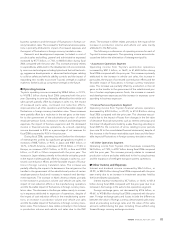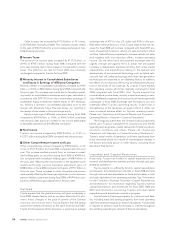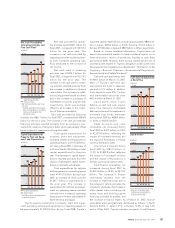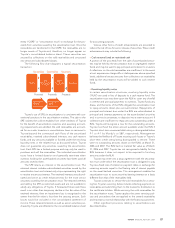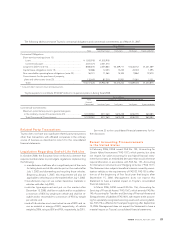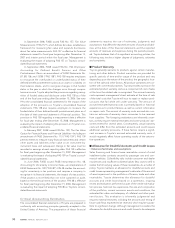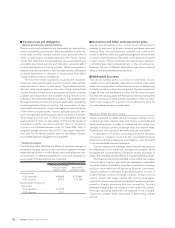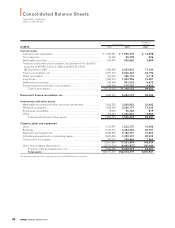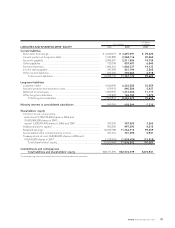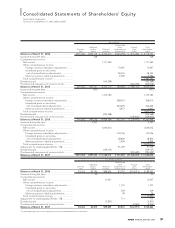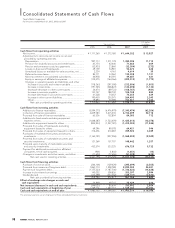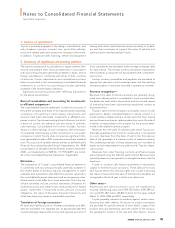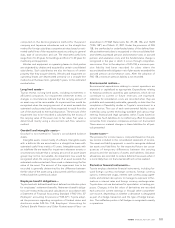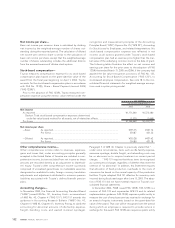Toyota 2007 Annual Report Download - page 95
Download and view the complete annual report
Please find page 95 of the 2007 Toyota annual report below. You can navigate through the pages in the report by either clicking on the pages listed below, or by using the keyword search tool below to find specific information within the annual report.
ANNUAL REPORT 2007 93
■Foreign Currency Exchange Rate Risk
Toyota has foreign currency exposures related to buying, selling
and financing in currencies other than the local currencies in
which it operates. Toyota is exposed to foreign currency risk
related to future earnings or assets and liabilities that are
exposed due to operating cash flows and various financial instru-
ments that are denominated in foreign currencies. Toyota’s most
significant foreign currency exposures relate to the U.S. dollar
and euro.
Toyota uses a value-at-risk analysis (“VAR”) to evaluate its
exposure to changes in foreign currency exchange rates. The
value-at-risk of the combined foreign exchange position repre-
sents a potential loss in pre-tax earnings that was estimated to be
¥51.9 billion as of March 31, 2006 and ¥33.1 billion as of March
31, 2007. Based on Toyota’s overall currency exposure (including
derivative positions), the risk during the year ended March 31, 2007
to pre-tax cash flow from currency movements was on average
¥30.9 billion, with a high of ¥33.1 billion and a low of ¥27.6 billion.
The VAR was estimated by using a Monte Carlo Simulation
method and assumed 95% confidence level on the realization
date and a 10-day holding period.
■Interest Rate Risk
Toyota is subject to market risk from exposures to changes in
interest rates based on its financing, investing and cash manage-
ment activities. Toyota enters into various financial instrument
transactions to maintain the desired level of exposure to the risk
of interest rate fluctuations and to minimize interest expense. The
potential decrease in fair value resulting from a hypothetical 100
basis point upward shift in interest rates would be approximately
¥75.6 billion as of March 31, 2006 and ¥99.5 billion as of March
31, 2007.
There are certain shortcomings inherent to the sensitivity
analyses presented. The model assumes interest rate changes
are instantaneous parallel shifts in the yield curve. However, in
reality, changes are rarely instantaneous. Although certain assets
and liabilities may have similar maturities or periods to repricing,
they may not react correspondingly to changes in market interest
rates. Also, the interest rates on certain types of assets and liabili-
ties may fluctuate with changes in market interest rates, while
interest rates on other types of assets may lag behind changes in
market rates. Finance receivables are less susceptible to prepay-
ments when interest rates change and, as a result, Toyota’s
model does not address prepayment risk for automotive related
finance receivables. However, in the event of a change in interest
rates, actual loan prepayments may deviate significantly from the
assumptions used in the model.
■Commodity Price Risk
Commodity price risk is the possibility of higher or lower costs
due to changes in the prices of commodities, such as non-ferrous
alloys (e.g., aluminum), precious metals (e.g., palladium, platinum
and rhodium) and ferrous alloys, which Toyota uses in the pro-
duction of motor vehicles. Toyota does not use derivative instru-
ments to hedge the price risk associated with the purchase of
those commodities and controls its commodity price risk by hold-
ing minimum stock levels.
■Equity Price Risk
Toyota holds investments in various available-for-sale equity
securities that are subject to price risk. The fair value of available-
for-sale equity securities was ¥1,469.1 billion as of March 31, 2006
and ¥1,679.8 billion as of March 31, 2007. The potential change in
the fair value of these investments, assuming a 10% change in
prices, would be approximately ¥146.9 billion as of March 31,
2006 and ¥168.0 billion as of March 31, 2007.


